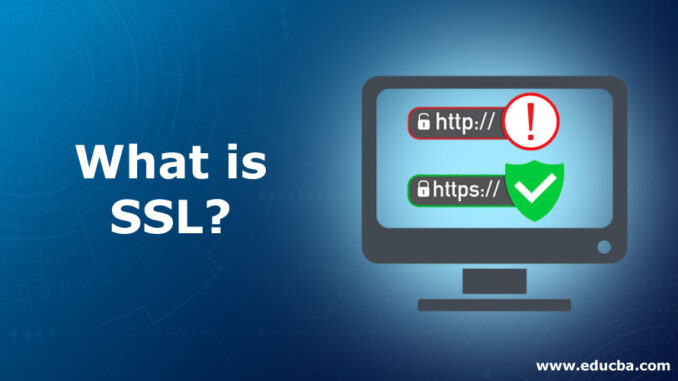
Table of Contents
What exactly is an SSL certificate?
An SSL certificate is a digital certificate that authenticates the identity of a website and allows for an encrypted connection. SSL is an abbreviation for Secure Sockets Layer, a security protocol that establishes an encrypted connection between a web server and a web browser.SSL certificates must be added to websites by businesses and organizations to safeguard online transactions and keep customer information private and secure.
In a nutshell, SSL secures internet connections and prohibits hackers from accessing or changing data exchanged between two systems. SSL safeguards the website you are visiting if you see a padlock icon next to the URL in the address bar.
Since its introduction roughly 25 years ago, there have been various versions of the SSL protocol, all of which have had security issues at some point. TLS (Transport Layer Security), which is still in use today, was a modified and renamed version that followed. However, the initials SSL remained, and the new version of the protocol is still commonly referred to by the old moniker.
How do SSL certificates function?
SSL protects data exchanged between users and websites, or between two systems, by making it impossible to read. It employs encryption methods to scramble data in transit, preventing hackers from reading it as it travels over the network. Names, addresses, credit card numbers, and other financial details are examples of potentially sensitive data.
The procedure is as follows:
A browser or server attempts to connect to an SSL-secured website (i.e., a web server).
The browser or server asks the web server to identify itself.
In response, the web server delivers a copy of its SSL certificate to the browser or server. The browser or server determines whether or not it trusts the SSL certificate. If it does, it notifies the webserver.
The web server then responds with a digitally signed acknowledgment, allowing an SSL-encrypted session to begin.
The browser or server and the webserver exchange encrypted data.
This is known as an “SSL Handshake” in some circles. While it may appear to be a lengthy procedure, it is completed in milliseconds.
The term HTTPS (which stands for HyperText Transfer Protocol Secure) appears in the URL when a website is secured by an SSL certificate. Without an SSL certificate, only the letters HTTP will appear, without the S for Secure. In addition, a padlock icon will appear in the URL address box. This communicates trust and reassures visitors.
To view the information about an SSL certificate, click the padlock symbol in the browser bar. SSL certificates typically include the following information:
The domain name for which the certificate was issued, the person, company, or device to whom it was granted, and the Certificate Authority that issued it
The digital signature of the Certificate Authority
Subdomains that are related
The certificate’s issue date The certificate’s expiry date
The open key (the private key is not revealed)
Why do you require an SSL certificate?
SSL certificates are required for websites to safeguard user data, validate website ownership, prevent attackers from building a false version of the site, and express trust to users.
If a website requires users to sign in, enter personal information such as credit card numbers, or see confidential information such as health benefits or financial information, the data must be kept private. SSL certificates serve to keep online interactions private and tell consumers that the website they are visiting is real and secure to exchange personal information.
More importantly for businesses, an SSL certificate is necessary for an HTTPS web address. HTTPS is the secure version of HTTP, which means that HTTPS websites use SSL to encrypt their traffic. Most browsers label HTTP sites that lack SSL certificates as “not secure.” This indicates to users that the site may not be trustworthy.
An SSL certificate aids in the security of information such as:
- Login information
- Bank account details or credit card transactions
- Personal information — such as complete name, address, date of birth, or phone number —
- Contracts and legal papers
- Medical documentation
- Exclusive information
- SSL Certificate Types
There are various sorts of SSL certificates with varying levels of validation. The six major types are as follows:
- Certificates with Extended Validation (EV SSL)
- Certificates that have been validated by an organization (OV SSL)
- Certificates with Domain Validation (DV SSL)
- SSL certificates with wildcard characters
- SSL certificates with multiple domains (MDC)
- Certificates for Unified Communications (UCC).
Is it possible to utilize an SSL certificate on several servers?
On the same server, one SSL certificate can be used for numerous domains. You can also utilize a single SSL certificate on numerous servers, depending on the provider. This is due to the Multi-Domain SSL certificates that we discussed earlier.
Multi-Domain SSL Certificates, as the name suggests, work with several domains. The specific issuing Certificate Authority determines the number. A Multi-Domain SSL Certificate differs from a Single Domain SSL Certificate, which is meant to secure a single domain as the name implies.
To further complicate matters, you may come across Multi-Domain SSL Certificates, commonly known as SAN certificates. SAN is an abbreviation for the Subject’s Alternative Name. Every multi-domain certificate has additional attributes (i.e., SANs) that can be used to identify additional domains that should be covered by a single certificate.
Unified Communications Certificates (UCCs) and Wildcard SSL Certificates both support multiple domains and an unlimited number of subdomains.

Leave a Reply